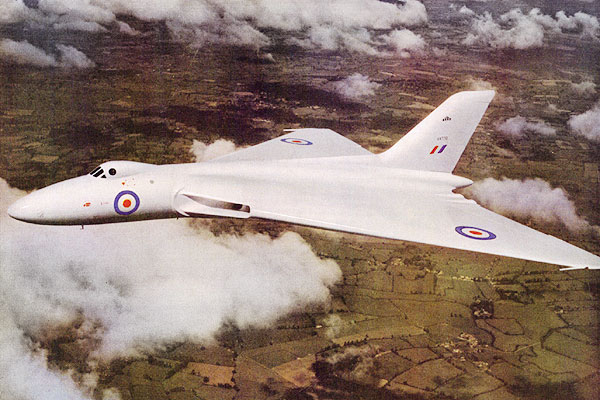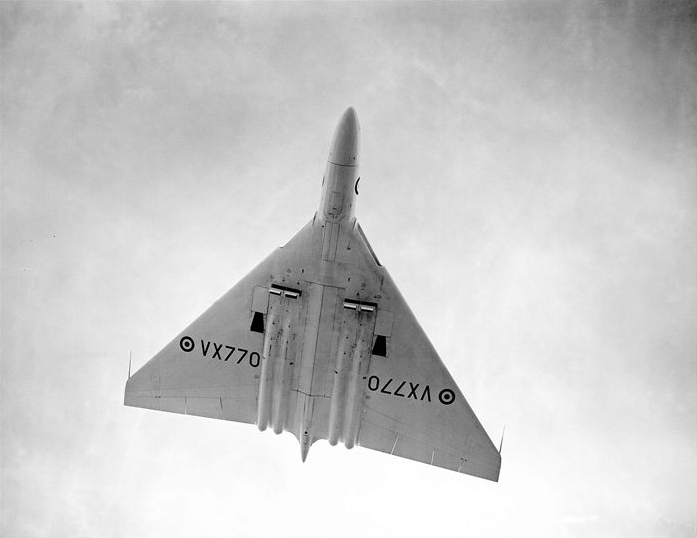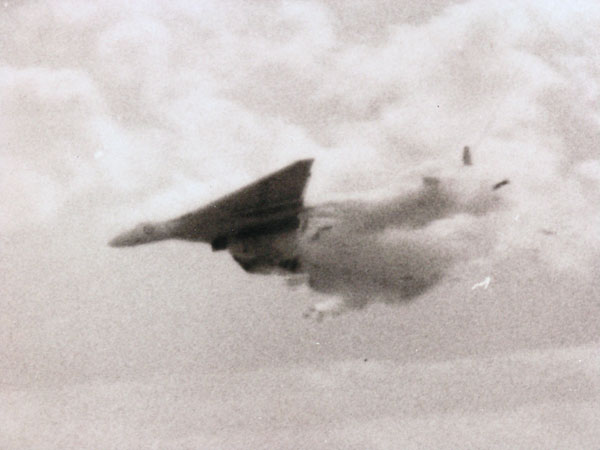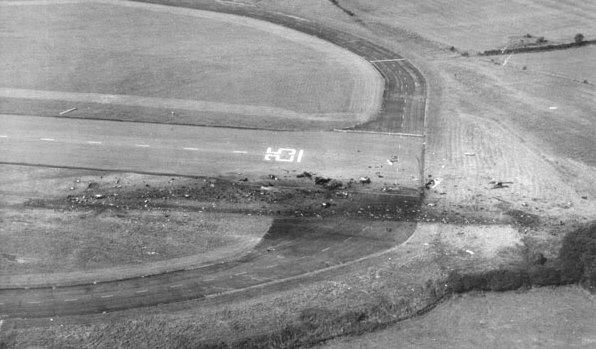
![]() 20 September 1958: The first prototype Avro Vulcan strategic bomber, VX770, piloted by Rolls-Royce test pilot Keith Roland Sturt, was on a test flight from the Rolls-Royce Flight Test Establishment, RAF Hucknall, when it diverted to make a scheduled fly-past for an air show being held at RAF Syerston in Nottinghamshire. Also aboard were Co-Pilot Ronald W. Ward of Fairey Aviation; Rolls-Royce Flight Engineer William E. Howkins; and Navigator, Flight Lieutenant Raymond M. (“Polly”) Parrott, Royal Air Force.
20 September 1958: The first prototype Avro Vulcan strategic bomber, VX770, piloted by Rolls-Royce test pilot Keith Roland Sturt, was on a test flight from the Rolls-Royce Flight Test Establishment, RAF Hucknall, when it diverted to make a scheduled fly-past for an air show being held at RAF Syerston in Nottinghamshire. Also aboard were Co-Pilot Ronald W. Ward of Fairey Aviation; Rolls-Royce Flight Engineer William E. Howkins; and Navigator, Flight Lieutenant Raymond M. (“Polly”) Parrott, Royal Air Force.
VX770 approched RAF Syerstone at 12:57 p.m. (GMT) and flew east along Runway 07–25 at about 250 feet (76 meters). As the Vulcan passed the control tower at an estimated speed of 350 knots, it began a right turn.

Witnesses saw a “kink” form in the leading edge of the Vulcan’s right wing, which then began to disintegrate from the leading edge aft. Wing surface panels could be seen being stripped off before the wing spar failed completely. Clouds of fuel from ruptured tanks trailed as the bomber rolled to the left. The top of the vertical fin came off, the nose pitched upward toward vertical, then straight down, and with both wings on fire, the airplane crashed near the east end of the runway.
All four crew members were killed, as were three RAF fire/rescue personnel on the ground. Several others were injured.



A short video clip of the fly-by and crash can be seen on You Tube:
The cause of the Vulcan’s wing failure was not determined. Metal fatigue was suspected. The airplane had been used in flight testing for six years and it is possible that it’s design limits may have been exceeded during that period. There was also speculation that vibrations from the new Rolls-Royce Conway “bypass turbojet” engine, which is now called a turbofan, may have weakened the wing.
According to the investigative report, Keith Sturt was considered to be an “above average” and “capable and careful” pilot. He had accumulated 1,644 hours of flight time over six years. He had flown VX770 for 91 hours, 40 minutes. Sturt was a former Flight Lieutenant of the Royal Air Force, having been inducted into the service in 1945.
VX770 was the first of two Type 698 prototypes built by A.V. Roe & Co., Ltd., at Woodford, Cheshire. It made its first flight 30 August 1951 with Chief Test Pilot R.J. “Roly” Falk. Originally equipped with Rolls-Royce Avon R.A.3 turbojet engines, these were soon replaced with more powerful Armstrong Siddely Sapphire A.S.Sa.6 engines. During modification in 1953, fuel cells were added to the wings. As production airplanes were built with Bristol Olympus Mk.102 engines, VX770 was modified accordingly. During its final flight, it was powered by Rolls-Royce Conway RCo.10 turbofans.
Keith Roland Sturt was born in Guildford, Surrey, England, 20 April 1929, the son of George Sturt and Daisy May Raveney Sturt. On 20 June 1957, Sturt married Mrs. Colin Weal Coulthard (née Norah Ellen Creighton) in Surrey.
© 2018, Bryan R. Swopes
RIP the crew. My mother was married to the Navigator, Flight Lieutenant Raymond Michael Parrott, or Polly as he was known to his friends.
Thanks, Gill.
I had just repaired a Television and the first picture I saw Was the column of smoke rising up. I worked at Hucknall at the time, I will never forget that RIP
I wonder if the engine weight difference, or failure to account for it, contributes. 2900 pounds each for the original vs 4500 pounds each for the fans.
I don’t know, John. Everything was experimental in those days. So many unknowns.
I was there with my dad it was a treat for my 10th birthday in October dad had been on Naval convoys WW2 he pushed me to the floor and shielded me all I really remember was the noise.
I’m sure you don’t do celebrities, but Jim Croce died in a Beech 18 50 years ago today. A middle of the night takeoff from Natchitoches, Louisiana after a concert.
Great site, Bryan. Thanks for the time you put into it.
Thank you, Willy. Yes, some times we do. I knew that Croce had died on this date, but didn’t know that it was in an airplane. It’s too late, right now, but I can research and write an article, then back publish it. It may take a while. But thank you for the suggestion. . . Ah! Some research luck: Although the full NTSB report is no longer available, I did find a summary which has most of the details that I need.
I was there on that fateful day, having just arrived with my elder brother & fiancé.
He worked for RR in another division, & I was a young aircraft buff.
Such a terrible think to witness, and it still remains a vivid memory.